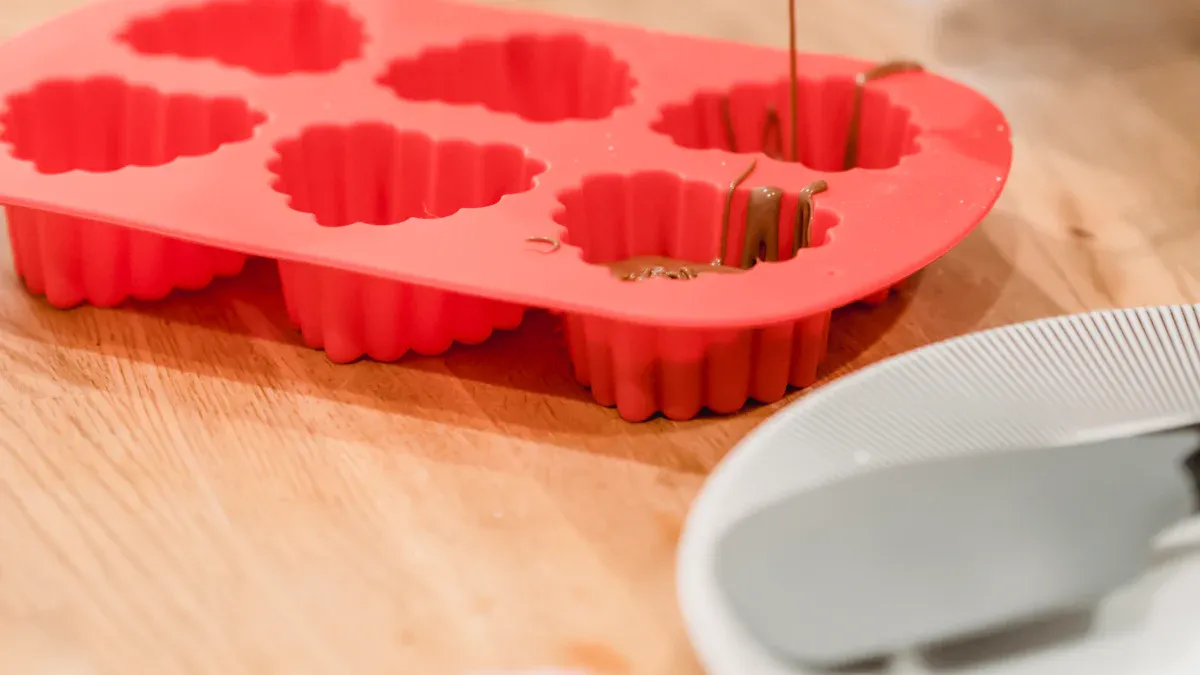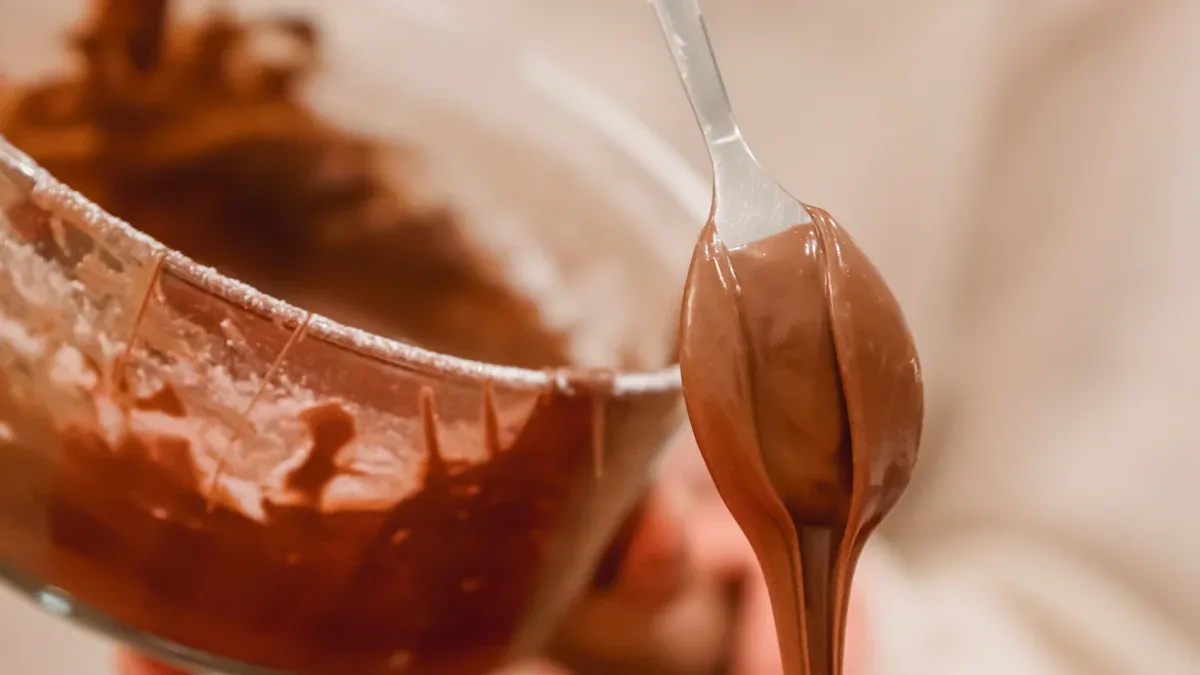
You can safely use silicone in the oven. Food-grade silicone handles high temperatures without breaking down. Silicone bakeware and silicone cooking pot lids resist heat, so you do not have to worry about melting. These products stay stable, making them a smart choice for baking and cooking.
Key Takeaways
- Use only food-grade silicone bakeware and lids that can safely handle oven temperatures up to 428°F (220°C) to avoid damage or melting.
- Always place silicone items on a sturdy baking sheet and keep them away from direct heat or oven walls to maintain their shape and safety.
- Clean silicone well before first use and after each use to prevent odors and stains, and avoid sharp tools to protect the material.
Silicone Oven Safety and Guidelines

Maximum Temperature Limits
You should always check the temperature rating before using silicone in your oven. Most food-grade silicone bakeware and silicone cooking pot lids can handle temperatures up to 428°F (220°C). Some products may even go higher, but you need to read the label or packaging for exact numbers. If you use silicone above its safe limit, it can lose its shape or even melt.
Tip: Place your silicone bakeware or silicone cooking pot lids on a baking sheet. This helps you move them in and out of the oven safely and keeps them steady.
Here is a quick reference table for common silicone temperature limits:
| Product Type | Typical Max Temperature |
|---|---|
| Silicone Bakeware | 428°F (220°C) |
| Silicone Cooking Pot Lids | 428°F (220°C) |
| Specialty Silicone Molds | 450°F (232°C) |
Food-Grade Standards and Chemical Safety
You want to use only food-grade silicone in your kitchen. Food-grade silicone does not contain fillers or harmful chemicals. It stays stable when you heat it, so it will not release toxins into your food. Always look for products labeled as “food-grade” or “BPA-free.” These labels show that the silicone meets safety standards.
Note: If you notice a strong chemical smell when you heat new silicone, wash it well before using it. Sometimes, leftover factory oils cause this smell, but it should go away after a few washes.
Precautions to Avoid Damage
You can keep your silicone bakeware and silicone cooking pot lids in good shape by following a few simple steps:
- Avoid using sharp tools or knives on silicone. These can cut or tear the material.
- Do not place silicone directly on open flames or heating elements. Silicone can burn if it touches direct heat.
- Let silicone cool before washing it. Sudden changes in temperature can weaken the material.
- Store silicone items flat or loosely rolled. This helps them keep their shape.
If you take care of your silicone kitchenware, you will enjoy safe and easy baking for a long time.
Using Silicone in Different Ovens
Conventional Ovens
You can use silicone bakeware and lids in a conventional oven without worry. These ovens heat from the bottom and top, so silicone items bake food evenly. Always place your silicone bakeware on a sturdy baking sheet. This helps you move it in and out of the oven safely. You should check the temperature rating on your silicone product before baking. Most silicone bakeware works well up to 428°F (220°C). If you bake at higher temperatures, you risk damaging the silicone.
Tip: Always preheat your oven before placing silicone inside. This helps your food cook evenly and keeps the silicone in good shape.
Convection Ovens
Convection ovens use a fan to circulate hot air. This cooks food faster and more evenly. Silicone bakeware works well in convection ovens. The fan does not harm the silicone. You may need to lower the baking temperature by about 25°F (15°C) because convection ovens cook faster. Always check your food a few minutes early to avoid overbaking.
- Place silicone items on the middle rack for best results.
- Avoid letting silicone touch the oven walls or heating elements.
Toaster Ovens
You can use small silicone molds and lids in toaster ovens. Toaster ovens heat up quickly and have less space, so you must be careful. Make sure your silicone item fits well and does not touch the sides or top of the oven. Use a small baking tray under your silicone bakeware for extra support.
Note: Watch your food closely in a toaster oven. Silicone can heat up faster in the small space, so baking times may be shorter than in a regular oven.
Tips for Using Silicone Bakeware and Silicone Cooking Pot Lids
Proper Placement in the Oven
You should always place silicone bakeware and silicone cooking pot lids on a flat, sturdy baking sheet. This gives your items extra support and helps you move them safely. Make sure the universal lids for cookware does not touch the oven walls or heating elements. Place your bakeware in the center of the oven for even heat. If you use silicone cooking pot lids, check that they fit well and do not hang over the edge of the pot.
Tip: Use oven mitts when handling hot silicone. The material can get very hot, even if it looks cool.
Adjusting Baking Times and Temperatures
Silicone bakeware may change how your food bakes. It does not heat up as fast as metal pans. You might need to add a few extra minutes to your baking time. Always check your food for doneness before removing it from the oven. If you use silicone cooking pot lids, they help trap steam and heat. This can make your food cook a bit faster. Lower the oven temperature by 5-10°F if you notice your food browning too quickly.
| Bakeware Type | Suggested Adjustment |
|---|---|
| Silicone Bakeware | Add 2-5 minutes to time |
| Silicone Cooking Pot Lids | Lower temp by 5-10°F |
Cleaning and Maintenance
You can clean silicone bakeware and silicone cooking pot lids with warm, soapy water. Use a soft sponge to avoid scratches. Most silicone items are dishwasher safe, but always check the label first. Dry your silicone items well before storing them. Store them flat or rolled up to keep their shape. If you notice stains or odors, soak the silicone in a mix of baking soda and water.
Note: Avoid using sharp tools or harsh cleaners. These can damage the silicone and shorten its life.
Common Issues and How to Prevent Them
Odor and Staining
You might notice that silicone bakeware sometimes holds onto strong smells or stains from certain foods. Foods like garlic, tomato sauce, or curry can leave behind odors or colors. To prevent this, always wash your silicone items right after use. Use warm, soapy water and a soft sponge. If you see stains or smell odors, soak the silicone in a mixture of baking soda and water for a few hours. Rinse well before using again.
Tip: Dry your silicone items completely before storing them. This helps prevent lingering smells.
Warping or Melting
Silicone can warp or melt if you use it above its temperature limit. Always check the maximum temperature on the label before baking. Place silicone bakeware on a sturdy baking sheet to keep its shape. Never let silicone touch direct heat, like oven coils or open flames. If you see your silicone changing shape or becoming sticky, stop using it.
Common causes of warping or melting:
- Using temperatures above 428°F (220°C)
- Placing silicone too close to heating elements
- Using damaged or low-quality silicone
Sticking and Release Problems
Sometimes, food sticks to silicone bakeware, even though it is nonstick. To help with release, lightly grease your silicone molds before the first use. You can use a small amount of oil or nonstick spray. Let your baked goods cool before removing them from the mold. This helps them come out cleanly.
Note: Avoid using sharp tools to remove food. Use a soft spatula or your hands to protect the silicone surface.
You can trust silicone bakeware and silicone cooking pot lids for safe oven use. Always check temperature ratings before baking. Choose food-grade products for best results. With proper care, you make baking and cooking easier.
Remember: Clean your silicone cooking pot lids after each use to keep them in top shape.
FAQ
Can you put silicone bakeware directly on the oven rack?
You should place silicone bakeware on a baking sheet. This gives it support and helps you move it safely in and out of the oven.
Does silicone change the taste of food?
Food-grade silicone does not change the taste of your food. If you notice a smell, wash the silicone well before using it again.
Can you use silicone bakeware in the microwave?
Yes, you can use silicone bakeware in the microwave. It handles microwave heat safely and does not melt or release harmful chemicals.
Post time: Jun-16-2025
